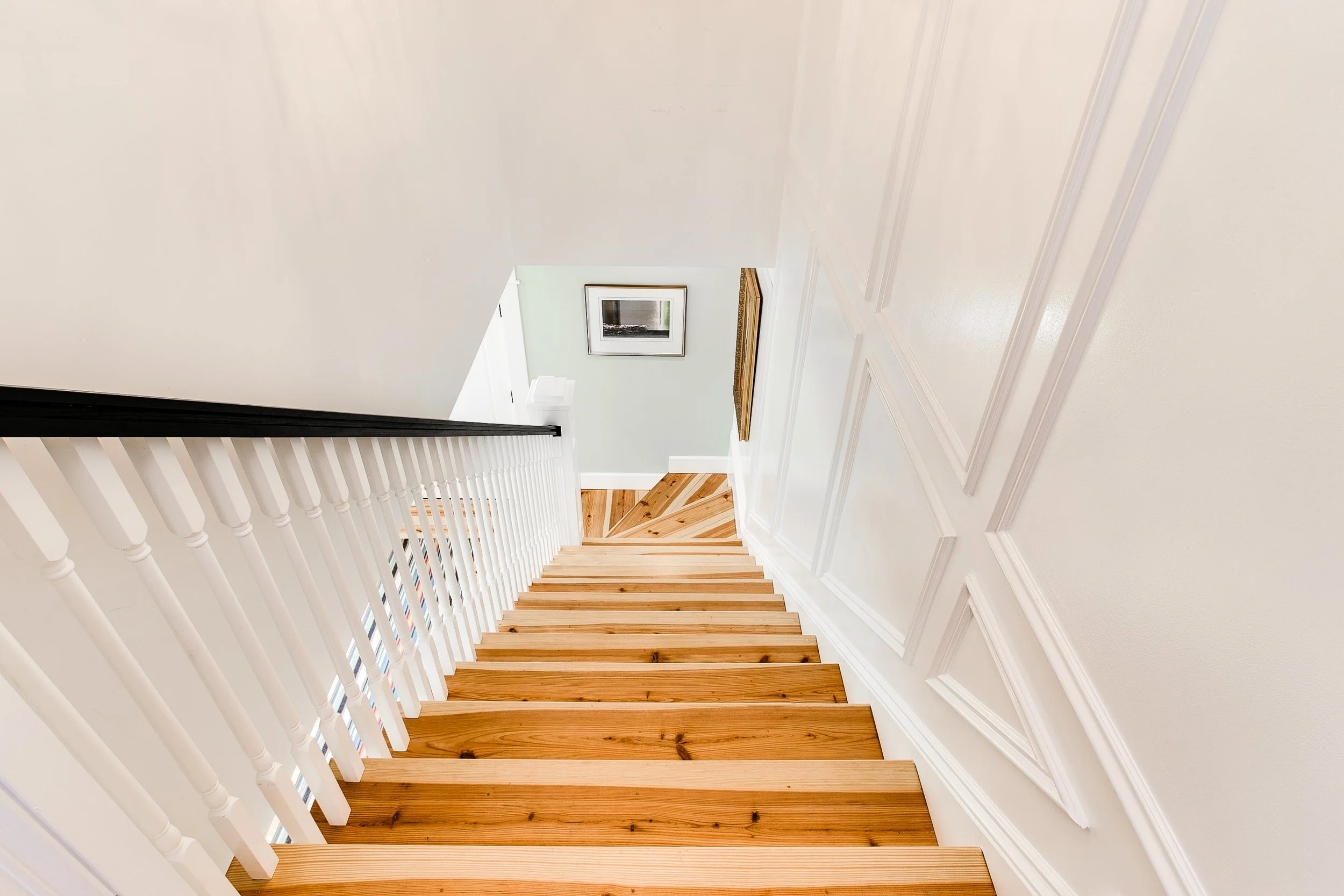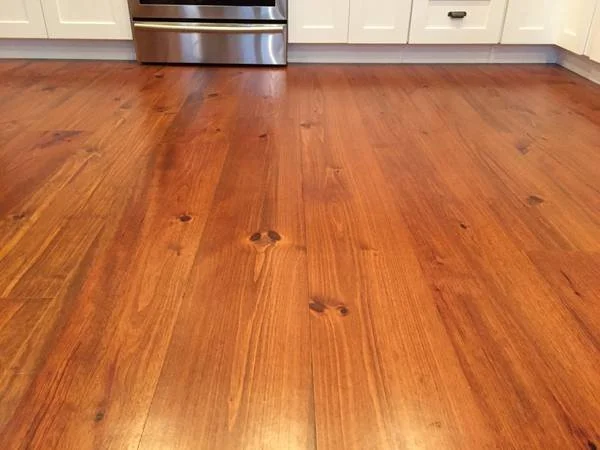What is Knotty Pine
Sometimes you feel like a knot, sometimes you don’t!
What is Knotty Pine
Rustic Southern Pine (Knotty) floors are not created equal, not even close. We produce Heart Pine flooring from Longleaf Pine timber, not building materials from farmed Loblolly pine. Our #2 Knotty Southern Pine floors can be compared to Character grade Heart Pine, with up to 50% heart content. What this means is our #2 knotty pine simply lacks the heart content to be deemed Bayou Rustic Heart Pine which requires a minimum of 50% visible heartwood. So, distance from the middle of the tree (heart) determines if our #2 becomes Heart Pine. This is quite different from mills producing building materials from younger timber. Our Knotty pine grade has always been our #1 seller by volume and remains the most versatile board we offer. In conclusion, #2 Rustic Southern Pine has knots as opposed to Clear grade but not enough heartwood to be called Heart Pine.
The color equals character.
What is New Heart Pine?
New Heart Pine is not new at all, not compared to dimensional lumber or farmed pine. While it is true the longleaf pines of old were allowed to grow hundreds of years and develop dense hearts, trees grown today do still develop some heartwood. The term Heart Pine refers to the non-living “heart” of a pine tree, as opposed to the outer living layers, known as sapwood. A pine tree’s heartwood is highly valued and preferred by many woodworkers and builders, because it is strong, hard, and has a beautiful reddish-gold color. Heartpine is a grade given to flooring with more than 50% visible heart content on the face over every board.
Matching Heart Pine Treads
What about select grade?
Homeowners buying floors online see a grade or term, such as “Select” Knotty Pine and assume it means ‘the best’. No, not all. Select, by definition, indicates ‘hand selected’ during the sorting process. Only problem, it is all ‘hand sorted’ unless you are keeping defects in the grade. Machines do not sort boards for things such as Heart Content, holes, cracks all of which matter, to say the least. Best advice when buying floors online, read the specifications online and ask questions.
Acclimation and moisture
Step 1: Make sure that the heating and air conditioning units are in operation at least five days before delivery of the flooring, during installation and after the flooring is installed. If it is not possible for permanent HVAC to be operating before, during and after installation, a temporary system that mimics normal living conditions may enable installation to proceed.
Acclimation, sometimes called conditioning, is the process of allowing wood to reach its equilibrium moisture content (EMC) within “normal living conditions.” It is also one of the most important steps of hardwood floor installation. Not properly acclimating or conditioning wood flooring may cause excessive expansion, shrinkage, dimensional distortion, or even structural damage.
If the flooring material being installed does not have specific acclimation and conditioning instructions, keep reading to find some basic steps to follow:
Acclimation Prep
Step 1: Make sure that the heating and air conditioning units are in operation at least five days before delivery of the flooring, during installation and after the flooring is installed. If it is not possible for permanent HVAC to be operating before, during and after installation, a temporary system that mimics normal living conditions may enable installation to proceed.
Moisture Differential and Sub- Floors
Step 2: Once the facility has been confirmed to be at the expected living condition, proceed with delivery of flooring material. Check the moisture content of the wood flooring as soon as it is received at the jobsite.
Step 3: Check the moisture content of the subfloor. The moisture content of the subfloor should coincide with the temperature and relative humidity of the jobsite, based on the temperature, relative humidity and average moisture content chart shown below. This moisture content reading will give you a good idea of where the conditions in the facility are being maintained and allow you to compare to the expected “in-use” conditions.
The age of your floor and installation pro matter- experience with Heart Pine a key.
Acclimation tip
Remember that wood is extremely sensitive to climate and moisture, and should always be stored so that conditions between 60 and 80 degrees Fahrenheit and 30 to 50 percent relative humidity can be maintained – in other words, normal living conditions in most homes. Extreme temperature and moisture levels can destroy your flooring before it’s even installed, so climate control during storage, transportation, and installation is vitally important.
Southern Pine is not a species
Our Alabama pine floors come from 100 year old mature trees, never clear cut. The soil & climate in the northern Alabama hills, along with harvestable stands of slow-growing mature timber produce consistent gorgeous floors. It absolutely matters where your pine is grown. Our mill has been in production for generations. We produce flooring specifically for your needs. We do not have inventory - we mill your square footage. Your ¾” floor is cut from the same batch of trees & cut with the same knife so it fits together perfectly & installs easily.
Southern Yellow Pine is not a species, but rather a description. Within this region grow ‘hard' pines (yellow) and soft pines (white); color is an attempt to distinguish the Yellow or “hard pines” from the Eastern White Pine or Red Pine. Inside of the Southern Yellow Pine geographic range are four major species: Shortleaf, Longleaf, Loblolly, and Slash, with another 8-9 sub species bringing the total to a baker’s dozen. And no, not all pine is created equal, not when you are talking about walking on it!
New Heart Pine before and after stain
Southern Pine uses
Southern Yellow Pine is a cornerstone in residential construction because of its strength, affordability, and adaptability. SYP is one of the strongest softwoods in North America, with a high strength-to-weight ratio, excellent bending and compression strength, and superior load-bearing performance. SYP’s natural beauty and durability make it ideal for rustic and traditional hardwood flooring. It’s also commonly used in subfloor systems due to its stiffness.
Sustainable and Eco-friendly
Fast growing, abundant and coniferous; anyone remember that term from science class? It means they do not have to be planted, the cones produce seeds when they fall. For this reason alone Southern Yellow Pine is among the most sustainable softwoods grown in the U.S.
What is New Heart Pine
What is New Heart Pine?
New Heart Pine is not new at all, not compared to dimensional lumber or farmed pine. While it is true the longleaf pines of old were allowed to grow hundreds of years and develop dense hearts, trees grown today do still develop some heartwood. The term Heart Pine refers to the non-living “heart” of a pine tree, as opposed to the outer living layers, known as sapwood. A pine tree’s heartwood is highly valued and preferred by many woodworkers and builders, because it is strong, hard, and has a beautiful reddish-gold color. Heartpine is a grade given to flooring with more than 50% visible heart content on the face over every board.
What is the best dog floor?
For a truly dog-friendly floor, look for materials with inherent character that can disguise everyday wear and tear. Our Southern Pine is an excellent example, with its "rustic character" evident in its natural color variations and knots. Over time, these floors develop a beautiful, rich patina that only age can create.
Minor marks and accidents are easily remedied. The natural character of Southern Pine allows for simple touch-ups with a colored pencil or even a sharpie. Many customers opt for a darker stain, which not only enhances the floor's beauty but also makes minor imperfections less noticeable and easier to repair. If you're looking for solutions to existing issues, the following tips may be helpful;
The best floor for a dog
Amazing Southern Pine great fit for hiding the inevitable.
Choosing the right or best floor for your dog is more about the finish than the species. A floor with a UV cured aluminum oxide offers good protection but can be difficult to touch up. In fact, repairing scratches on UV flooring could require buffing to fix scratches. More extensive damages might even require a tear out to repair.
On the other hand, a finished floor using an oil-based polyurethane may scratch more easily but it is much easier to hide or repair. Before we put “our two cents in,” readers should know that we (Bayou Rustic Flooring) sell unfinished and prefinished flooring. We have no agreement with any manufacturer or finished product. However, if you are discussing the best floor for pets, Monocoat by Rubio starts at the top for Bayou Rustic. For more information, visit our Monocoat series.
Dog friendly means easy to repair
Prefinished floors as purchased with an existing finish have an ultraviolet or UV curing process that uses aluminum oxide as the topcoat. These UV topcoats are protection for the wood itself, but the surface will scratch. Not a big deal if you have finished flooring, but UV can be tougher to repair. If you sand one spot the UV vanishes, and color matching becomes an issue. Customers end up having to replace much larger sections than just the damaged area.
Homemade scratch repair
Olive oil and vinegar. Mixing equal parts olive oil and vinegar creates a natural wood filler perfect for tiny scratches. Mix the solution together & apply it with a clean rag, done.
Lemon juice and oil. Mixing together equal parts fresh lemon juice and oil—canola oil, vegetable oil, or olive oil would all work. Apply to the scratch with a microfiber cloth, being sure to wipe in the direction of the wood grain, done.
Walnuts or Brazil Nuts. Simply rub the nut over the scratch and let the natural oils fill in the dent. Because of their texture, walnuts and Brazil nuts work the best. We have no 1st hand knowledge; however, trusted sources swear by this one.
What is the difference between prime and rustic grade Caribbean Heart Pine?
The main difference between rustic and prime grade Caribbean Heart Pine flooring is the presence and size of knots and sapwood, which affects the color variation and overall character of the wood.
The main difference between rustic and prime grade Caribbean Heart Pine flooring is the presence and size of knots and sapwood, which affects the color variation and overall character of the wood.
Prime Grade: This grade is more uniform in color, with a range from golden to reddish-brown. It has very few, tiny pin knots and limited sapwood, giving it a more classic and elegant look.
Rustic Grade: This grade features more and larger knots, along with more sapwood. This results in greater color variation and a more distinct "character" or "rustic" appearance, though it's not considered lower quality.
Ford Dealership South Florida
A great substitute for Antique Heart Pine
Caribbean Heart Pine is considered a good substitute for Antique Heart Pine because it has the right characteristics and materials to be "antiqued," meaning a process can be applied to it to create the aged look and feel of reclaimed antique heart pine.
Caribbean Heart Pine floors and ceiling












